|
|
|
Sort Order |
|
|
|
Items / Page
|
|
|
|
|
|
|
| Srl | Item |
| 1 |
ID:
179678


|
|
|
|
|
| Summary/Abstract |
Countries are making important efforts decarbonising their electricity generation mix. In this context, improving the operational efficiency enables better use to be made by renewables and the grids. However, the location of new capacity might be relevant from the social welfare point of view when private decisions might affect the power system efficiency.
|
|
|
|
|
|
|
|
|
|
|
|
|
|
|
|
| 2 |
ID:
088266
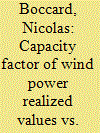

|
|
|
|
|
| Publication |
2009.
|
| Summary/Abstract |
For two decades now, the capacity factor of wind power measuring the average energy delivered has been assumed in the 30-35% range of the name plate capacity. Yet, the mean realized value for Europe over the last five years is below 21%; accordingly private cost is two-third higher and the reduction of carbon emissions is 40% less than previously expected. We document this discrepancy and offer rationalizations that emphasize the long term variations of wind speeds, the behavior of the wind power industry, political interference and the mode of finance. We conclude with the consequences of the capacity factor miscalculation and some policy recommendations
|
|
|
|
|
|
|
|
|
|
|
|
|
|
|
|
| 3 |
ID:
150458
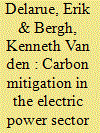

|
|
|
|
|
| Summary/Abstract |
In Europe, CO2 emissions from the electric power sector and energy intensive industries are capped under a cap-and-trade system (i.e., the EU ETS). When other indirect measures are taken to impact emissions in a specific sector under the cap (such as a push for renewables in the electric power sector), this has implications on the overall allowance price, and on CO2 emissions both from this specific sector and the other sectors under the cap. The central contribution of this paper is the derivation of impact curves, which describe these interactions, i.e., the impact on allowance price and the shift of emissions across sectors. From a set of detailed simulations of the electric power system operation, a so-called “emission plane” is obtained, from which impact curves can be derived. Focus is on interactions between CO2 abatement through fuel switching and measures affecting the residual electricity demand (such as deployment of renewables) in the electric power sector, as well as on interactions with other sectors, both in a short-term framework. A case study for Central-Western Europe is presented. The analysis reveals a substantial impact of renewables on CO2 emissions, and hence on emissions shifts across sectors and/or on the CO2 price.
|
|
|
|
|
|
|
|
|
|
|
|
|
|
|
|
| 4 |
ID:
166719
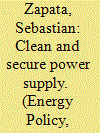

|
|
|
|
|
| Summary/Abstract |
Across the world, the electricity industry is changing with the advent of renewable energy sources such as solar and wind power. As these are exposed to intermittency, seasonality, and global-climate-variation, policy-makers' concerns are now shifting towards security of supply. In fact, the industry confronts three conflicting goals: security of supply, competitive prices to customers, and environmental protection. In this context, and given the multiple uncertainties of technology transformation, this paper uses modelling-based scenario analysis to investigate different extreme and plausible futures. Simulation is used to analyse policies aimed at increasing the penetration of renewables and to explore how these energy sources may affect system reliability. This paper explores the effect of incorporating renewables in Colombia, where a large hydroelectric component has led to insufficient electricity being available during droughts and to high electricity price volatility. Though not intuitive at first glance, this paper shows that renewables may contribute to: i) increased security of supply through complementarity, e.g., it does not rain when the sun shines; ii) reduced price volatility in the medium-term, and iii) increased industry sustainability.
|
|
|
|
|
|
|
|
|
|
|
|
|
|
|
|
| 5 |
ID:
176783


|
|
|
|
|
| Summary/Abstract |
The paper examines the interactions between nuclear and variable renewable generation capacities (vRES) under various assumptions in the broader V4 region. Four exploratory scenarios are analysed with high and low penetration levels of vRES and nuclear applying electricity dispatch and unit commitment models. The assessment quantifies the impacts of the joint evolution of these technologies, measuring the effect on utilisation rates, wholesale prices, market values of vRES, energy not supplied (ENS) and the changing production and trading patterns in the projected 2035 electricity system. The results are indicative of a ‘double competition’ between (i) nuclear and vRES technologies within the merit order and (ii) between the NPPs in the region. If the ambitious V4 nuclear plans are indeed execute, NPPs will compete for limited export opportunities during times of high vRES production periods. Thus, coordination of long term energy policies within the V4 region is critical to manage nuclear and vRES developments and trade patterns with the aim of improving flexibility and security of supply to mitigate the negative economic impact on the electricity system.
|
|
|
|
|
|
|
|
|
|
|
|
|
|
|
|
| 6 |
ID:
126556


|
|
|
|
|
| Publication |
2013.
|
| Summary/Abstract |
This paper provides a financial survey of a small sample of Czech photovoltaic (PV) plants. To evaluate the extent of market losses, we calculate the shadow market price of solar electricity. From the profit and loss accounts of the PV plants and the shadow market price we estimate the total economic loss generated by PV electricity sector in the Czech Republic. The presented microeconomic approach has two main advantages: firstly, we work with real observed data, which offsets the drawback of a limited sample. Secondly, the profit accounting calculation enables sensitivity analysis with respect to key variables of the plants. We show that money invested in PV plants would generate an annual loss of 8%. Given the estimated solar assets of CZK 165.6 billion (EUR 6.6 billion) as of December 2011, this translates in at least CZK 12.6 billion lost in the Czech solar sector in 2012. About 43% of this loss is due to high technology costs and corresponds to pure dead weight loss, while the remaining 57% constitute the redistributive profit component of subsidies. Finally, we calculate that unless electricity prices increase or technology costs decrease approximately sevenfold, PV plants will remain loss making.
|
|
|
|
|
|
|
|
|
|
|
|
|
|
|
|
| 7 |
ID:
167237


|
|
|
|
|
| Summary/Abstract |
Three main drivers underlie states’ intent to expand gas supply: energy security, geopolitics and climate goals. Such considerations also drive Greece’s expansive gas policy, but come with significant caveats. First, pipeline politics entails geopolitical costs and inflated anticipated gains. Second, while gas supply has yielded energy security for Greece, its cost-effectiveness is contentious. Third, the gas option obscures the transition to smart, clean energy sources and systems. A rational actor model within a rationalist-weak cognitivist framework can account for Greece’s gas policy. Yet, its limited success points to the need for a clean energy policy promising higher climate, energy and geopolitical gains.
|
|
|
|
|
|
|
|
|
|
|
|
|
|
|
|
| 8 |
ID:
183586
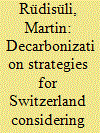

|
|
|
|
|
| Summary/Abstract |
Decarbonizing the energy system by electrification of heat and transport is only effective when using low-carbon electricity sources. As many countries such as Switzerland rely on imported electricity to meet their demand, the greenhouse gas (GHG) content of electricity imports must be correctly accounted for. By assuming an average GHG content for each amount imported, impacts of electricity required in peak periods are underestimated because additional (marginal) demand is primarily met with fossil power plants. This study employs a model to capture marginal GHG contents of imported electricity from a direct and indirect (life-cycle) perspective at an hourly resolution. Implications on GHG are explored for various electricity demand and supply scenarios including electrification of heat and transport, large-scale expansion of renewables, and nuclear phase-out. We find that depending on the scenario, the average GHG intensity of consumed electricity may double, while diurnal and seasonal variations are even larger. Nonetheless, results show substantial GHG mitigation of up to 45% with electrification in case of deploying a diversified electricity generation portfolio including photovoltaics and wind. For optimal GHG mitigation, short-term flexibility as provided by hydropower is necessary to manage electricity surpluses. The main challenge, however, surrounds seasonal energy storage including sector coupling.
|
|
|
|
|
|
|
|
|
|
|
|
|
|
|
|
| 9 |
ID:
115126


|
|
|
|
|
| Publication |
2012.
|
| Summary/Abstract |
A reconfigurable network can change its topology by opening and closing switches on power lines. We use real wind, solar, load, and cost data and a model of a reconfigurable distribution grid to show that reconfiguration allows a grid operator to reduce operational losses as well as to accept more intermittent renewable generation than a static configuration can. Net present value analysis of automated switch technology shows that the return on investment is negative for this test network when considering only loss reduction, but that the investment is attractive under certain conditions when reconfiguration is used to minimize curtailment.
|
|
|
|
|
|
|
|
|
|
|
|
|
|
|
|
| 10 |
ID:
096626


|
|
|
|
|
| Publication |
2010.
|
| Summary/Abstract |
We investigate the concomitance of intermittent wind powered generation (WPG) with load to assess its system value as the cost of replacing its output, hour by hour, using more intensively thermal technologies. The difference with its actual cost defines a social cost of wind power which is further divided into a technological and an adequacy component. Whereas the former may become negligible once thermal technologies pay for carbon emissions, the latter is a lower bound on WPG structural weakness w.r.t. thermal technologies.
We apply our procedure to Germany, Denmark, Spain, France, Portugal and Ireland using hourly load and WPG data over several years. Our empirical findings show that there is a grain of truth in both the pros and the cons of wind power. The system value of WPG varies from three quarters of the equivalent thermal cost of electricity (on a yearly basis) but the incompressible adequacy cost represents a premium over the cost of serving yearly load in a system ranging around one-fifth.
|
|
|
|
|
|
|
|
|
|
|
|
|
|
|
|
| 11 |
ID:
097465


|
|
|
|
|
| Publication |
2010.
|
| Summary/Abstract |
We investigate the concomitance of intermittent wind powered generation (WPG) with load to assess its system value as the cost of replacing its output, hour by hour, using more intensively thermal technologies. The difference with its actual cost defines a social cost of wind power which is further divided into a technological and an adequacy component. Whereas the former may become negligible once thermal technologies pay for carbon emissions, the latter is a lower bound on WPG structural weakness w.r.t. thermal technologies.
We apply our procedure to Germany, Denmark, Spain, France, Portugal and Ireland using hourly load and WPG data over several years. Our empirical findings show that there is a grain of truth in both the pros and the cons of wind power. The system value of WPG varies from three quarters of the equivalent thermal cost of electricity (on a yearly basis) but the incompressible adequacy cost represents a premium over the cost of serving yearly load in a system ranging around one-fifth.
|
|
|
|
|
|
|
|
|
|
|
|
|
|
|
|
| 12 |
ID:
149953
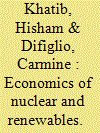

|
|
|
|
|
| Summary/Abstract |
This paper provides an assessment of the economic challenges faced by both nuclear power and “new” renewable electricity technologies. The assessment reflects the need to incorporate new renewables into power grids and issues faced in dispatching power and their effect on traditional electricity technologies as well as the need for transmission extension and/or grid reinforcement.
|
|
|
|
|
|
|
|
|
|
|
|
|
|
|
|
| 13 |
ID:
097194


|
|
|
|
|
| Publication |
2010.
|
| Summary/Abstract |
Climate change is one of the most important issues our world faces today and it is responsible for a number of natural disasters that threaten human life and existence. Carbon dioxide, produced from almost every energy consuming activity, is the dominant greenhouse gas responsible for global warming. Water desalination is an energy intensive activity, and when it is powered by conventional energy sources, significant amounts of CO2 are released. For every cubic metre of fresh water produced, there is a 2 kg of CO2 reduction if renewable energy sources (RES) are used instead of electricity from the local grid. On the other hand, the cost of fresh water produced by desalination is much less if conventional sources of energy are used.
Making appropriate policy choices require information on both costs and benefits. So here we estimate the critical CO2 cost, above which desalination units should use renewable energy instead of conventional energy sources. It was found that the critical CO2 emissions cost can be close to the CO2 capture cost and in many cases less than the penalties imposed by the European Commission. Several case studies of water desalination in the Aegean islands verify the conclusions.
|
|
|
|
|
|
|
|
|
|
|
|
|
|
|
|
| 14 |
ID:
097195


|
|
|
|
|
| Publication |
2010.
|
| Summary/Abstract |
Climate change is one of the most important issues our world faces today and it is responsible for a number of natural disasters that threaten human life and existence. Carbon dioxide, produced from almost every energy consuming activity, is the dominant greenhouse gas responsible for global warming. Water desalination is an energy intensive activity, and when it is powered by conventional energy sources, significant amounts of CO2 are released. For every cubic metre of fresh water produced, there is a 2 kg of CO2 reduction if renewable energy sources (RES) are used instead of electricity from the local grid. On the other hand, the cost of fresh water produced by desalination is much less if conventional sources of energy are used.
Making appropriate policy choices require information on both costs and benefits. So here we estimate the critical CO2 cost, above which desalination units should use renewable energy instead of conventional energy sources. It was found that the critical CO2 emissions cost can be close to the CO2 capture cost and in many cases less than the penalties imposed by the European Commission. Several case studies of water desalination in the Aegean islands verify the conclusions.
|
|
|
|
|
|
|
|
|
|
|
|
|
|
|
|
| 15 |
ID:
114287
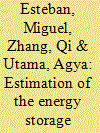

|
|
|
|
|
| Publication |
2012.
|
| Summary/Abstract |
Renewable energy systems are often criticized because of their intermittency and need for substantial amount of backup in terms of other energy sources or storage. The present paper proposes a method to estimate the required amount of storage backup for a mostly solar and wind system that uses also biomass and hydroenergy as minor components of the electricity mix. An hourly simulation was carried out to determine the amount of electricity that could be produced based on the meteorological conditions of year 2001 in Japan, and this was compared with the maximum electricity demands imposed in the system for each month of the year. The system thus proposed has 100% chance of meeting around 40% of the electricity demand between 11:00 and 18:00, and the optimum scenario obtained (a 2:1 mix of solar to wind energy) required around 40 TW of storage to balance the extra electricity demand that occurs during the summer in Japan. It appears unlikely that the batteries in EV in vehicles will be able to meet this storage requirement in the future, though the system is able to adequately meet the electricity demand during the majority of the year, and hence showcases the viability of renewable energy.
|
|
|
|
|
|
|
|
|
|
|
|
|
|
|
|
| 16 |
ID:
166980
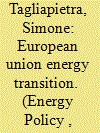

|
|
|
|
|
| Summary/Abstract |
Over the last decade, the EU has pursued a proactive climate policy and has integrated a significant amount of renewables into the energy system. These efforts have proved successful and continuing along this pathway, increasing renewables and improving energy efficiency, would not require substantial policy shifts. But the EU now needs a deeper energy transformation to decarbonise in line with the Paris agreement and to seize the economic and industrial opportunities offered by this global transformation. A full-fledged energy transition is becoming economically and technically feasible, and its cost would be similar to that of maintaining the existing system, if appropriate policies and regulations are put in place. In short, the EU could benefit from deep decarbonisation irrespective of what other economies around the world do. The transition can also be socially acceptable, if the right policies are put in place to control and mitigate the distributional effects of deeper decarbonisation. The time to act is now, as policy choices made up to 2024 will define the shape of the EU energy system by 2050. This article outlines the key priorities that, in our view, should drive the EU energy and climate policy making for the new institutional cycle 2019–2024.
|
|
|
|
|
|
|
|
|
|
|
|
|
|
|
|
| 17 |
ID:
121392


|
|
|
|
|
| Publication |
2013.
|
| Summary/Abstract |
Since Fukushima many are calling for a shutdown of nuclear power plants. To see whether such a shutdown would reduce the risks for health and environment, the external costs of nuclear electricity are compared with alternatives that could replace it. The frequency of catastrophic nuclear accidents is based on the historical record, about one in 25 years for the plants built to date, an order of magnitude higher than the safety goals of the U.S. Nuclear Regulatory Commission. Impacts similar to Chernobyl and Fukushima are assumed to estimate the cost. A detailed comparison is presented with wind as alternative with the lowest external cost. The variability of wind necessitates augmentation by other sources, primarily fossil fuels, because storage at the required scale is in most regions too expensive. The external costs of natural gas combined cycle are taken as 0.6 €cent/kWh due to health effects of air pollution and 1.25 €cent/kWh due to greenhouse gases (at 25€/tCO2eq) for the central estimate, but a wide range of different parameters is also considered, both for nuclear and for the alternatives. Although the central estimate of external costs of the wind-based alternative is higher than that of nuclear, the uncertainty ranges overlap.
|
|
|
|
|
|
|
|
|
|
|
|
|
|
|
|
| 18 |
ID:
149831


|
|
|
|
|
| Summary/Abstract |
SIDS have both opportunities and challenges – economic, social and environmental vulnerability – for low carbon development. Economically, they are highly dependent on international trade; they have limited domestic markets, too small to provide significant scale economies; their exports are constraint by their isolation and remote location. We provide an overview of current energy situation in SIDS, their goals to adopt low carbon economic development paths, policies already in place or required to achieve the goals and challenges to implement their plans and strategies. The focus is on energy policy landscape that needs to be addressed in order to scale-up renewable energy technologies needed to stimulate low carbon economic growth. We find that SIDS face four key barriers to renewable energy development: information to improve the energy information network by strengthening existing information systems and building awareness of renewable energy; financing mechanisms for renewable energy projects, including regional loan structures and technical assistance to banks; policy supports to implement regulatory frameworks that enable renewable energy development; and building technical capacity among players in the renewable energy field. We recommend “policy enablers” that underlie what could positively impact on renewable energy goals and more broadly energy efficiency and climate change.
|
|
|
|
|
|
|
|
|
|
|
|
|
|
|
|
| 19 |
ID:
163569


|
|
|
|
|
| Summary/Abstract |
This paper provides estimates of quantile regression models of the relationship between Italian day-ahead electricity prices, the supply of renewables and the inception of a new cable (SAPEI, linking Sardinia with the Italian peninsula), in the 2006–2015 time window. The results confirm the merit order effects detected in the existing literature, both for photovoltaics and wind power, more strongly in market conditions characterised by moderately low price levels and with some implied increase in volatility. The new cable has apparently challenged the ability of power generating companies to extract value through price spikes, has mitigated volatility, and its effects have been complementary with those of renewables. Effects from photovoltaics are more sensitive to robustness checks. Differences across zonal markets are nonetheless detected.
|
|
|
|
|
|
|
|
|
|
|
|
|
|
|
|
| 20 |
ID:
176844


|
|
|
|
|
| Summary/Abstract |
When multiple power plants are curtailed at the same time and in the same region, electricity system costs rise. If transmission lines are congested, these costs might be amplified and spatially more concentrated, because there are less spatial spill-overs. We study how such costs and their distribution depend on the market design (nodal pricing or uniform pricing). We extend the literature on curtailment by considering space and market design, and the literature on market design by considering curtailment. We expose a DC load-flow model for Germany to severe correlated curtailment scenarios. We find that additional costs are moderate. For the simulated week, curtailment of 9.3% non-renewable capacity reduces welfare by 2.7% (uniform pricing). With nodal pricing, welfare loss can be reduced by 1.5%. Distributional differences are multiple times larger. For nodal pricing, producer surplus rises more, and costs are spatially more concentrated at the curtailed power plants. Consumer surplus becomes lower. The difference is unlikely to justify changes of the current market design. If also wind or photovoltaic feed-in is unavailable, economic impacts can decrease or increase, but remain in the same order of magnitude. The spatial electricity system structure matters more than the volume of curtailment.
|
|
|
|
|
|
|
|
|
|
|
|
|
|
|
|
|
|
|
|
|